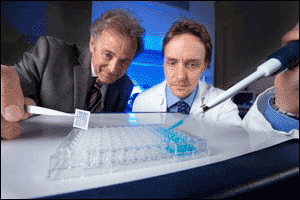Print Technology Used to Develop Biomedical Sensors
 Print this article | Send to Colleague Print this article | Send to Colleague
According to a report in Printed Electronics World (PEW) this past week, Welsh scientists intend to use the latest printing technologies to develop a low cost biosensor capable of diagnosing a range of health conditions. The aim is to place living antibodies into a suitable ink that would then be printed onto a compatible substrate or material to form a disposable sensor, capable of being mass produced at low cost.
As the article explains, antibody based assays are routinely used to detect specific medical conditions, but use of these tests is limited because they need to be carried out in laboratories by highly skilled technicians, which is costly and time consuming. By contrast, a printed array of antibodies speeds up the testing process while reducing the expertise and complexity of equipment needed, introducing the possibility of hand held electronic scanners and much quicker diagnosis. It allows this aspect of patient care to be moved from hospital or laboratory to the GP surgery, releasing expensive hospital resources for other activities. It could also prove invaluable for use in emergency humanitarian situations and in remote areas.
The project is supported by the Welsh Government's Academic Expertise for Business (A4B), an EU funded initiative to stimulate and encourage collaboration between educational institutions and industry. Edwina Hart, Minister for Business, Enterprise, Technology, and Science, said A4B supports the commercial exploitation of new ideas in Wales and in this instance, in the high growth area of medical diagnostics.
"This is a good example of how we can maximize the economic impact of our universities by bringing together world leading expertise in our research centers with the high tech expertise of industry," Hart said in the PEW article.
The industrial collaboration is led by Swansea University's Welsh Centre of Printing and Coating, which is teaming up with the Institute of Life Science and industry. The partnership includes Micropharm, which produces antibodies at its base in Newcastle Emlyn, Abertawe Bro Morgannwg University NHS Trust, and Innovia Films of Cumbria, which will provide advice on the choice of substrate and materials.
 Professor Tim Claypole, who is leading the research, said the project is at the forefront of international research and represents a major advance in the printing of biomedical sensors. "It builds on previous research on the printing of functional materials, but is a completely novel application that would not progress without the support of Welsh Government funds. The availability of low cost, disposable sensor technology is a core requirement for the early diagnosis of disease. The use of antibodies as sensors targeted to detect specific human conditions is regarded as one of the next major advances in health care. Professor Tim Claypole, who is leading the research, said the project is at the forefront of international research and represents a major advance in the printing of biomedical sensors. "It builds on previous research on the printing of functional materials, but is a completely novel application that would not progress without the support of Welsh Government funds. The availability of low cost, disposable sensor technology is a core requirement for the early diagnosis of disease. The use of antibodies as sensors targeted to detect specific human conditions is regarded as one of the next major advances in health care.
"Volume printing is also the most practical method to achieve low cost disposable sensor technology. This will take innovation from the bench to the bedside and develop the tools and technologies to move the process of diagnosis forward and bring it into the surgery and home," Professor Claypole explained in the PEW report. The initial focus will be developing a proof of concept device that will open opportunities to develop antibody sensors
In the photo on the right, Professor Tim Claypole (left) and Dr Chris Phillips, Senior Research Officer, at Swansea University in Wales, U.K., compare a printed array with a multi-well plate that is currently used.
|
|

